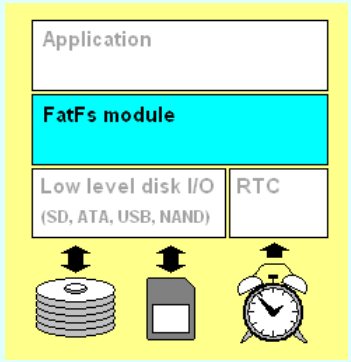(一),什么是文件管理系统
答:数据在PC上是以文件的形式储存在磁盘中的,这些数据的形式一般为ASCII码或二进制形式。简单点说就是:管理磁盘上的文件的方法的代码!
如:我们写到SD卡上面的数据管理一下,更科学的方法来管理
http://elm-chan.org/fsw/ff/00index_e.html,官网介绍 Resources下面是源码
(二),我们在移植时主要是那些函数?
答:Device Control Interface(硬件接口函数)
- disk_status - Get device status 选择操纵的模块,此处用SD卡
- disk_initialize - Initialize device 初始化函数
- disk_read - Read sector(s) 读
- disk_write - Write sector(s) 写
- disk_ioctl - Control device dependent features
- get_fattime - Get current time
(三),例程:
1,我们用的是0.09版本的
2,CC936.c中文字体库
①新建工作区间
/* Register work area for each volume (Always succeeds regardless of disk status) */
f_mount(0,&fs); //(文件管理系统)注册一个工作区间,工作空间命名为0。
那么工作区间的命名范围是什么呢?
答:
FRESULT f_mount (
BYTE vol, /* Logical drive number to be mounted/unmounted */
FATFS *fs /* Pointer to new file system object (NULL for unmount)*/
)
{
FATFS *rfs;
if (vol >= _VOLUMES) /* Check if the drive number is valid */
return FR_INVALID_DRIVE;
vol就是f_mount的第一个形参(命名),当他的值大于等于 _VOLUMES,就会返回错误
#define _VOLUMES 1 //can define 9
/* Number of volumes (logical drives) to be used. */
Parameters(官网)
-
Drive
- Logical drive number (0-9) to register/unregister the work area. FileSystemObject
- Pointer to the work area (file system object) to be registered.
②然后再工作区间里面新建文件
/* function disk_initialize() has been called in f_open */
/* Create new file on the drive 0 */
res = f_open(&fnew, "0:newfile.txt", FA_CREATE_ALWAYS | FA_WRITE );
OPEN的属性:
1.怎么打开呢?
FA_CREATE_ALWAYS 总是以创建总是新建的形式打开这个文件
FA_WRITE:此文件只能写
2.看下open函数
FRESULT f_open (
FIL* FileObject, /* Pointer to the blank file object structure */ 文件指针,把打开的文件关联到这个指针连
const TCHAR* FileName, /* Pointer to the file neme */ 文件名字
BYTE ModeFlags /* Mode flags */ 属性
);
属性:
| Value | Description |
|---|---|
| FA_READ | Specifies read access to the object. Data can be read from the file. Combine with FA_WRITE for read-write access. |
| FA_WRITE | Specifies write access to the object. Data can be written to the file. Combine with FA_READ for read-write access. |
| FA_OPEN_EXISTING | Opens the file. The function fails if the file is not existing. (Default) |
| FA_OPEN_ALWAYS | Opens the file if it is existing. If not, a new file is created. To append data to the file, use f_lseek function after file open in this method. |
| FA_CREATE_NEW | Creates a new file. The function fails with FR_EXIST if the file is existing. |
| FA_CREATE_ALWAYS | Creates a new file. If the file is existing, it is truncated and overwritten. |
可以第一次打开用:FA_CREATE_NEW,之后打开用:FA_OPEN_EXISTING(已存在)就可以了
或者:总是打开,总是关闭
当用到:FA_CREATE_ALWAYS时,我们要将 #define _FS_READONLY 0 /* 0:Read/Write or 1:Read only */ 打开
3.对于返回值(Return Values):我们只测试:FR_OK(是否成功)
③往该文件内写数据
if ( res == FR_OK )
{
res = f_write(&fnew, textFileBuffer, sizeof(textFileBuffer), &bw);
f_close(&fnew); 写完之后,把该文件关掉
}
④关掉之后再打开它
res = f_open(&fnew, "0:newfile.txt", FA_OPEN_EXISTING | FA_READ); // FA_READ:此时打开定义可读
⑤读取数据
res = f_read(&fnew, buffer, sizeof(buffer), &br);
⑥打印之后关闭
printf("\r\n %s ", buffer);
/* Close open files */
f_close(&fnew);
⑦在文件系统中注册掉刚才开辟的“0”工作区间
/* Unregister work area prior to discard it */
f_mount(0, NULL);
(四)文件管理系统与SD卡的关联!

1,Application:就是我们主函数中使用的那些上层函数
2,中间是文件系统模块,文件系统要操纵底层SD卡的时候呢还需要 Low level disk I/O,这一部分驱动,这一部分驱动需要我们自己写
/*-------------------------- SD Init ----------------------------- */
Status = SD_Init();
if (Status!=SD_OK )
{
return STA_NOINIT;
}
else
{
return RES_OK;
}
}
和
/*-----------------------------------------------------------------------*/
/* Return Disk Status */
DSTATUS disk_status (
BYTE drv /* Physical drive nmuber (0..) */
)
{
return RES_OK;
}
底层的磁盘的读/写
/*-----------------------------------------------------------------------*/
/* Read Sector(s) */
DRESULT disk_read (
BYTE drv, /* Physical drive nmuber (0..) */
BYTE *buff, /* Data buffer to store read data */
DWORD sector, /* Sector address (LBA) */
BYTE count /* Number of sectors to read (1..255) */
)
{
if (count > 1) //多个磁盘
{
SD_ReadMultiBlocks(buff, sector*BLOCK_SIZE, BLOCK_SIZE, count);
/* Check if the Transfer is finished */
SD_WaitReadOperation(); //循环查询dma传输是否结束
/* Wait until end of DMA transfer */
while(SD_GetStatus() != SD_TRANSFER_OK);
}
else //单个磁盘
{
SD_ReadBlock(buff, sector*BLOCK_SIZE, BLOCK_SIZE);
/* Check if the Transfer is finished */
SD_WaitReadOperation(); //循环查询dma传输是否结束
/* Wait until end of DMA transfer */
while(SD_GetStatus() != SD_TRANSFER_OK);
}
return RES_OK;
}
/*-----------------------------------------------------------------------*/
/* Write Sector(s) */
#if _READONLY == 0
DRESULT disk_write (
BYTE drv, /* Physical drive nmuber (0..) */
const BYTE *buff, /* Data to be written */
DWORD sector, /* Sector address (LBA) */
BYTE count /* Number of sectors to write (1..255) */
)
{
if (count > 1)
{
SD_WriteMultiBlocks((uint8_t *)buff, sector*BLOCK_SIZE, BLOCK_SIZE, count);
/* Check if the Transfer is finished */
SD_WaitWriteOperation(); //等待dma传输结束
while(SD_GetStatus() != SD_TRANSFER_OK); //等待sdio到sd卡传输结束
}
else
{
SD_WriteBlock((uint8_t *)buff,sector*BLOCK_SIZE, BLOCK_SIZE);
/* Check if the Transfer is finished */
SD_WaitWriteOperation(); //等待dma传输结束
while(SD_GetStatus() != SD_TRANSFER_OK); //等待sdio到sd卡传输结束
}
return RES_OK;
}
#endif /* _READONLY */
IO控制为空(直接返回OK)
/*-----------------------------------------------------------------------*/
/* Miscellaneous Functions */
DRESULT disk_ioctl (
BYTE drv, /* Physical drive nmuber (0..) */
BYTE ctrl, /* Control code */
void *buff /* Buffer to send/receive control data */
)
{
return RES_OK;
}
嵌入式初学者,看到此文的大神们,有什么错误的地方多多意见啊!
